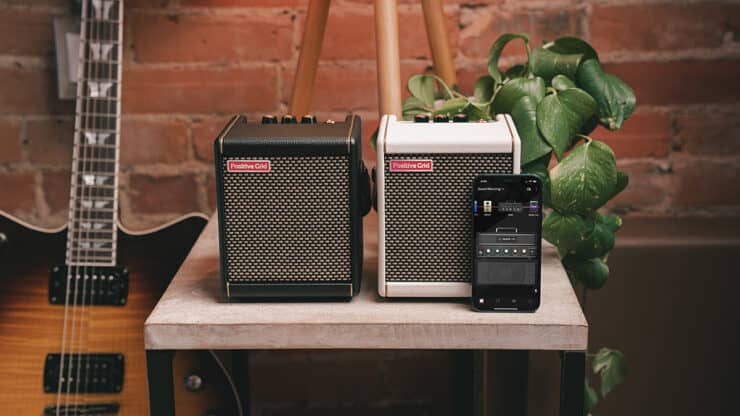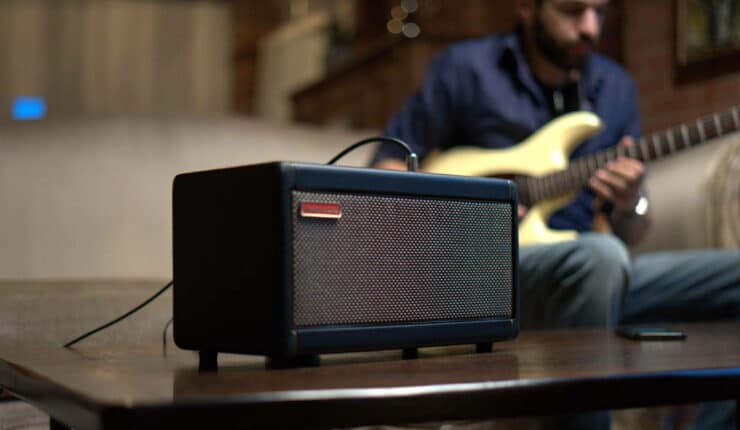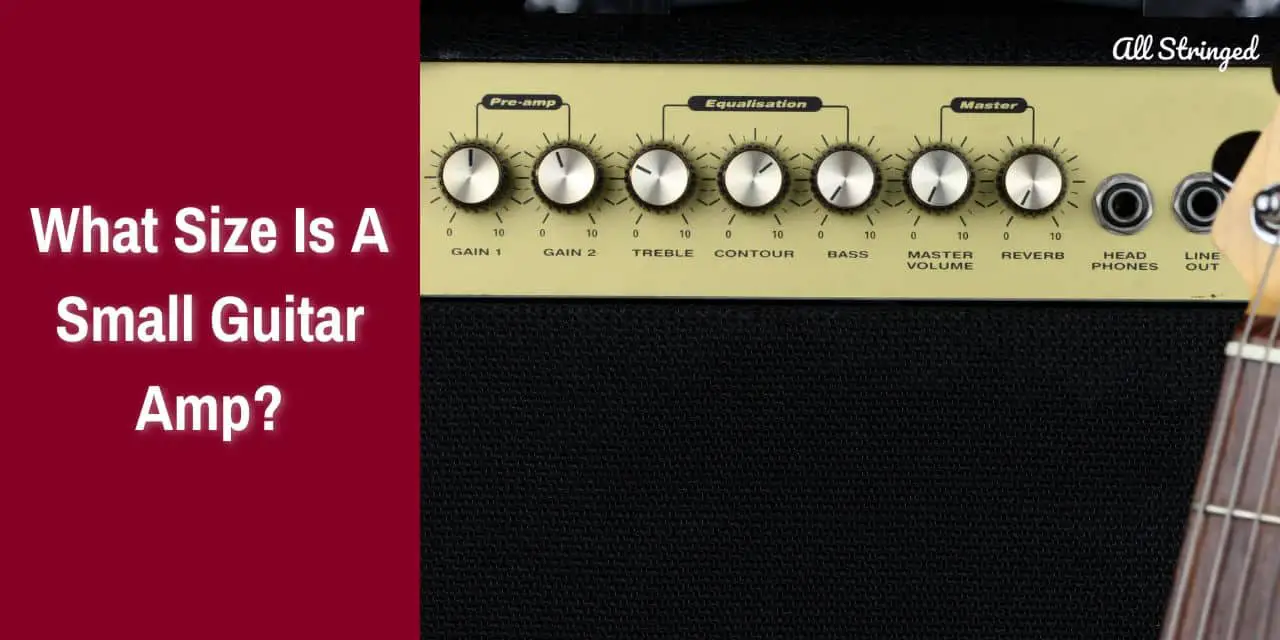Greetings fellow guitarists! Are you curious about what size a small guitar amp is? If yes, then keep reading! A small amp can be a great asset to any guitarist as it is convenient, light and easy to transport. It also produces good sound quality and can fit in any small space. In this article, we will explore what size a small guitar amp is and why it is such a great choice. So, let’s get started and find out what size a small guitar amp is!
What is a small guitar amp?
When it comes to playing the guitar, having the right amp can make a world of difference. While there are several options available in the market, small guitar amps have been gaining more and more popularity among musicians and guitarists. These compact devices offer an impressive range of benefits, including portability, affordability, and surprisingly powerful sound output.
>>> Click here to read our review about the Top 15 Best Small Guitar Amps <<<
A small guitar amp, as the name suggests, is a compact amp designed specifically for electric guitars. It is typically smaller in size and much more lightweight compared to its larger counterparts, such as full-size combo amps or stack systems. While they might be diminutive in stature, these small amps are capable of producing impressive sound quality that is well-suited for practice sessions, small gigs, or even home recording setups.
While larger amps have their merits, small guitar amps also offer a plethora of benefits to greatly enhance your playing experience. Here are some of the benefits of owning a small guitar amp and how it can amplify your musical journey.

#1. Portability and convenience
One of the standout benefits of a small guitar amp is its portability. Musicians who frequently travel or need to move their equipment from one location to the other will greatly appreciate the lightweight nature of these amps. Small guitar amps are easily transportable, making them ideal for rehearsals, jam sessions, and gigs in intimate venues. Moreover, their compact size will ensure that they don’t take up much space in a practice room or on stage, making them perfect for musicians who value convenience.
#2. Affordability without sacrificing quality
Another significant benefit of small guitar amps is their affordability. Compared to large amps, they tend to be much more budget-friendly, making them easily accessible to musicians of all levels. Despite their lower price range, manufacturers like Boss, Marshall, Fender, and more have focused on ensuring that sound quality remains competitive. Modern small amps often incorporate advanced digital technology and modeling capabilities, allowing them to easily emulate a variety of sought-after tones. This versatility will provide guitarists with a range of sounds to experiment with, covering music genres from blues to heavy metal.
#3. Surprising power and sound performance
While small guitar amps might not match the sheer volume or projection of their large counterparts, they are by no means weak when it comes to sound performance. Thanks to the latest technological advancements, many small guitar amps come equipped with features that enhance their power and projection, ensuring they can still produce a punchy and dynamic sound. This is especially true when paired with high-quality speakers or when utilized in recording scenarios. Musicians and guitarists can achieve impressive sonic results even at lower volumes, which makes these amps perfect for late-night practice sessions or home recording environments.
#4. Versatility and tonal options
Modern small guitar amps come equipped with a variety of built-in effects, amp modeling, and tone-shaping options. This versatility allows the guitarist to experiment with different sounds and genres without the need for additional pedals or equipment. From high-gain crunch to vintage blues tones, a small guitar amp will cater to a wide range of playing styles and musical preferences. This versatility will be especially valuable for musicians who enjoy exploring different sonic landscapes.
#5. Recording capabilities
Small guitar amps are not limited to live performances and practice sessions. They can also be excellent tools for home recording. With advancements in technology, many small guitar amps offer direct recording options using USB or dedicated audio outputs. This means you’ll be able to connect the amp to your computer or recording interface and capture high-quality quality tracks without the need for complex setups or additional microphones. This recording capability makes small guitar amps an essential asset for aspiring home studio enthusiasts and professional guitarists alike.
#6. Practice-friendly features
Small guitar amps are designed with the purpose of practice in mind. They often come equipped with headphone jacks, allowing you to practice silently without disturbing others around you. Moreover, many models offer auxiliary inputs, allowing you to connect your smartphone or music player and play along with backing tracks or your favorite songs. These features make small guitar amps a convenient and efficient tool for honing your skills and developing your playing technique.
What size is a small guitar amp in the market?
Small guitar amps come in a wide variety of sizes, with each size offering unique characteristics that can greatly impact your sound. From the intimate tones of a compact 1×8” to the thunderous projection offered by the 2×12” configuration, understanding the different sizes can help you make a well-informed decision when choosing your ideal small guitar amp. Here are the different sizes of small guitar amps and their benefits.
#1. 1×8”
The 1×8” configuration is an incredibly popular choice for small guitar amps, especially those designed for practice and home use. Despite its compact size, this configuration can deliver surprisingly rich and balanced tones. The smaller speaker size emphasizes clarity and responsiveness, which makes it suitable for genres like jazz, blues, and acoustic styles. 1×8” sized amps are able to capture nuances and details in your playing, making them perfect for bedroom practice, recording, or intimate performances.
#2. 1×10”
The 1×10” configuration manages to strike the perfect balance between portability and enhanced low-end response. With a slightly bigger speaker size, these amps offer increased depth and warmth compared to the 1×8” counterparts. The extended low-end response will be beneficial to genres that require a fuller sound, such as rock, pop, and country. 1×10” sized amps offer a versatile tonal palette, which makes them suited for both practice and small live performances.
#3. 1×12”
The 1×12” configuration is a classic choice for small guitar amps. Such amps offer a well-rounded sound with a good balance of low-end, midrange, and high-end frequencies. This configuration will provide a more pronounced and robust presence, making them ideal for a wide range of musical genres and playing styles. The 1×12” setup is an amazing choice among gigging musicians as it provides ample projection and can easily fill small to medium-sized venues without the need for additional speakers.
#4. 2×10”
The 2×10” setup delivers a unique combination of wide dispersion and enhanced midrange presence. The dual 10” speakers will give you increased power handling and a broader soundstage compared to single-speaker setups. This configuration is well-suited for guitarists looking for a punchy, focused sound with excellent projection. It is favored particularly by blues and rock players who are looking for a vintage-inspired tone and a dynamic response. The 2×10” setup is ideal for musicians who value portability but need a larger sound footprint.
#5. 2×12”
The 2×12” configuration is renowned for its impressive power, projection, and versatility. With multiple 12” speakers, this setup is capable of delivering a robust, full-bodied sound with a commanding presence. The larger speaker size results in an enhanced low-end response, making it suitable for music genres that require a heavy, aggressive sound like hard rock and metal. The 2×12” setup will be ideal for stage performances as it can deliver ample volume and fill larger venues without the need for additional amplification.
How to choose the right size small guitar amp?
Selecting the appropriate size of a small guitar amp will be important for achieving the desired sound and ensuring optimal performance. To make a well-informed decision, it is important to consider power needs, especially in relation to the specific genre or style of music you play. Here, you will get to know how to choose the right size small guitar amps for your musical endeavors.
Assess your playing environment
You need to consider the space where you usually play, whether it is a bedroom, a small practice room, or a larger venue. Smaller spaces might not require as much power as larger venues, allowing you to go for a smaller amp. Meanwhile, if you frequently perform in larger venues, you will require an amp with sufficient power and projection to fill the space effectively.

Define your playing style
Different music genres have varying power needs. Analyze the style of music that you typically play and the sonic characteristics associated with it. For instance, say that you play blues, jazz, and acoustic, such genres typically benefit from amps having lower power outputs as they emphasize clarity and responsiveness rather than sheer volume. Smaller amp sizes like 1×8” or 1×10” will be suitable for such genres.
Meanwhile, if you play rock, pop, or country, such genres require amps that have more power to produce a fuller sound. Amp sizes like 1×12” or 2×10” are capable of offering a balanced tone and adequate projection for live performances.
For hard rock and metal guitarists, these genres demand higher power outputs and increased headroom to achieve a heavier and more aggressive sound. Larger amp sizes like 2×12” or higher might be necessary for handling the dynamic range and producing the desired tone.
Calculate the power requirements
For estimating the power needs of your guitar amp, you need to consider factors like venue size, band dynamics, headroom, distortion, and more.
Larger venues will require more power for filling the space effectively. As a general guideline, a small guitar amp in the range of 15-30W is suitable for small venues whereas medium-sized venues might require amps in the range of 30-50W. For larger venues or outdoor performances, guitar amps with power outputs of 50W or higher are recommended.
If you perform with other musicians, you should consider the overall sound balance. A louder band might require a more powerful amp to cut through the mix. Communication with bandmates and sound engineers will help determine the appropriate power needs.
If you prefer a clean tone with headroom to spare, you should go for an amp with a higher power. If you rely on amp distortion or play in a band that uses high-gain settings, a lower-powered amp will be sufficient.
Different types of small guitar amps in the market
When it comes to small guitar amps, there is a wide variety of options to choose from. There are different types of amps available, each offering distinct features and tonal characteristics. Whether you are a beginner, an expert, a traveling musician, or a studio enthusiast, understanding the different types of small guitar amps will help you select the perfect match for your playing style and musical preferences. Here are the different types of small guitar amps and their qualities to help you choose the best one and unlock your desired tone.
#1. Solid-state amps
Solid-state amps are known for their solid-state circuitry, reliability, and affordability. These amps utilize transistors for amplifying the guitar signal, resulting in a clean, transparent sound. Solid-state amps are often lightweight, which makes them highly portable and suitable for practice, rehearsals, and small gigs. While these amps lack the natural warmth and harmonic complexity of tube amps, they do excel in their durability, versatility, and ability to produce consistent tones across different volume levels.
#2. Tube amps
Tube amps or also known as valve amps are revered for their warm, organic, and dynamic sound. These amps utilize vacuum tubes for amplifying their guitar signal, providing a rich harmonic response and natural compression. Tube amps are highly sought after by musicians who value the vintage, classic rock, and blues tones that they deliver. Even though tube amps tend to be heavier, need occasional tube replacements, and come with a higher price tag, their unmatched tonal qualities and touch-sensitive response make them a particular favorite among musicians and discerning guitarists.

#3. Digital modeling amps
Digital modeling amps make use of Digital Signal Processing (DSP) for replicating the sounds of various amplifiers and effects. These amps offer a vast array of amp models and effects, allowing for precise customization of tonal sculpting. Digital amps are quite versatile and often come with advanced features like USB connectivity, direct recording capabilities, and extensive editing software. They are a popular choice for both recording studios and home studios, where flexibility and ease of use are essential.
#4. Hybrid amps
Hybrid amps combine the best of both solid-state and tube amp technologies. These amps typically come with a tube preamp section paired with a solid-state power amp. This hybrid design aims to deliver the warmth and character of tube amps while retaining the reliability and affordability of solid-state amps. These amps offer a balance between vintage tube tones and modern convenience. They often provide added features like built-in effects, power attenuation options, and versatile tone-shaping controls.
Tips to make the most of using small guitar amps
Small guitar amps offer a compact and convenient solution for practice, recording, and intimate performances. While they might not offer the sheer power of larger guitar amps, small guitar amps do come with their unique charm and benefits. To make the most of your playing experience with a small guitar amp, there are a few key tips to keep in mind. Here are those essential tips to remember when playing with small guitar amps –
#1. Embrace the low-volume advantage
One of the primary advantages of using small guitar amps is their ability to provide great tone at low volume levels. You must embrace this advantage by exploring the tonal possibilities achievable at lower volume settings. You should experiment with different gain levels, EQ settings, and pickup selections for finding the sweet spot where your small amp truly shines. By exploring low-volume dynamics, you will be able to uncover unique tonal nuances and develop a more nuanced playing style.
#2. Experiment with pedals
Small guitar amps often come with limited built-in effects compared to their larger counterparts. To expand your tonal palette, you must experiment with external pedals. These pedals can add additional flavors and textures to your sound, including overdrive, modulation, delay, and reverb. You should consider investing in a few essential pedals that align with your preferred genre and experiment with different pedal combinations to create your signature sound. Small guitar amps work exceptionally well with pedals as they offer the nuances of each effect to shine through.
#3. Utilize the tone controls
While small guitar amps come with simplified control layouts, you shouldn’t underestimate the power of the tone controls available. You must spend time familiarizing yourself with the amp’s EQ settings, including midrange, bass, and treble controls. These adjustments could significantly impact the tone, allowing you to dial in the right amount of warmth, presence, and clarity. Experiment with different EQ settings to find the right tonal balance that complements your playing style and desired sound.
#4. Positioning and room acoustics
You must consider the positioning of your small guitar amp and the acoustic characteristics of the room that you’re playing in. Small amps can be quite sensitive to room reflections and resonances. You need to experiment with different amp placements, such as elevating it off the ground or angling it for better projection. Moreover, if you are in a reflective room, you should consider using rugs, curtains, or acoustic panels to minimize unwanted reflections and improve the overall sound quality.
#5. Practice dynamic playing
Small guitar amps can be sensitive to your playing dynamics. You must take advantage of that by practicing and refining your dynamic playing techniques. Pay close attention to how your picking attack, finger pressure, and volume knob adjustments affect the amp’s response. Further, you should work on creating a wide range of dynamics, from delicate and soft passages to powerful and aggressive movements. By mastering dynamic playing, you’ll be able to extract the maximum expression and emotion from your guitar amp.
#6. Protect your ears
While small guitar amps might seem less powerful than larger amps, it is important that you still protect your hearing. Prolonged exposure to high volume levels may cause hearing damage. You need to invest in a pair of quality musician’s earplugs to attenuate the sound without compromising the overall listening experience. Taking care of your hearing will ensure that you can continue to play and enjoy music for years to come.
FAQs
What size is a small guitar amp?
Small guitar amps typically range from 3-15 watts. These amps are designed to be compact and portable, making them ideal for practice and small gigs. They are usually designed with fewer controls and lower wattage than larger amps, allowing for more efficient portability and easier use.
What are the benefits of using a small guitar amp?
Small guitar amps are great for practice and small gigs because of their portability and ease of use. They also tend to be more affordable than larger amps, making them a great choice for beginners. Small amps are also less likely to cause disruption in small venues, making them ideal for gigs where a loud and powerful sound is not necessary.
What should I consider when choosing a small guitar amp?
When choosing a small guitar amp, it’s important to consider the power, tone, and features available. You should also consider the size of the amp and how portable it is, as well as the price. It’s also important to consider the type of sound you are looking for, as different amps have different sounds. Finally, make sure to try out the amp before you buy it to make sure it meets your needs.



